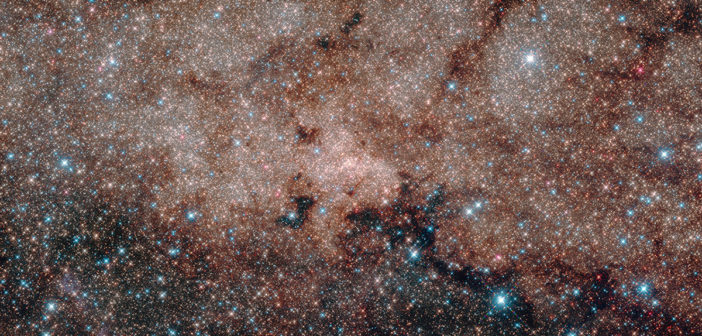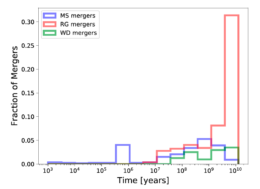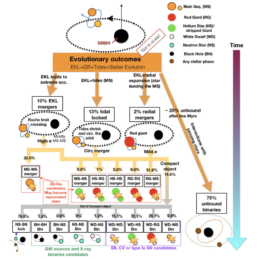What happens to binary stars under the influence of a nearby supermassive black hole? A new study shows that things can go one of two ways — being torn apart or becoming closer than ever.

An artist’s impression of an X-ray binary, many of which are seen in the galactic center. [ESA/NASA/Felix Mirabel]
Life in Galactic Downtown
There’s a lot going on in the galactic center. The crowded stellar environs near the Milky Way’s central black hole have long been studied in order to understand how the presence of a nearby black hole can shape stellar populations in our galaxy and others.
A quick peek at the center of the Milky Way reveals that it plays host to an unusually large number of interesting astrophysical phenomena like stellar mergers, hyper-velocity stars, and X-ray sources that could point to cataclysmic variables or binary systems with a neutron-star or stellar-mass-black-hole component.
How do these various unusual objects form in the galactic center? One possibility is that ordinary, garden-variety binary stars do strange things when they evolve in the extreme environment near a supermassive black hole
Binary Systems Through the Ages
To explore this scenario, a team of astronomers led by Alexander Stephan (University of California, Los Angeles) simulated the evolution of main-sequence binaries near a supermassive black hole. Specifically, they used Monte Carlo simulations of binary systems in the inner 0.33 light-years of a Milky-Way-like galaxy with a four-million-solar-mass black hole at its center.
Stephan and coauthors considered how the dynamics of binary systems with a range of starting masses would change over time as close encounters with other stars, gentle nudges from more distant objects, and the looming gravitational influence of the black hole warp and disturb their orbits.
While the orbits of the binary systems change over time due to gravitational interactions, the individual stars are busy evolving as well — a process that the authors captured by using a single-star stellar evolution code. Post-main-sequence evolution is important for the dynamics of a binary system since it can lead to mass transfer between the stars or even stellar mergers.
So Long, Partner
If you belong to a binary system and you’re hoping to spend the rest of your days with your companion, the news isn’t good: the authors found that after a few hundred million years, 75% of binary systems have been torn apart by gravitational interactions.
Of the remaining 25%, about half end up merging due to dynamical perturbations or because one star has swelled into a red giant and engulfed the other. The other half have even more exotic outcomes, becoming close binary systems containing white dwarfs, neutron stars, or black holes.
Clearly, the presence of a nearby supermassive black hole shakes up the evolution of otherwise ordinary binary stars: these rare systems are the precursors to Type Ia supernovae, cataclysmic variables, and compact object mergers that can generate gravitational waves.
Citation
“The Fate of Binaries in the Galactic Center: The Mundane and the Exotic,” Alexander Stephan et al 2019 ApJ 878 58. doi:10.3847/1538-4357/ab1e4d


